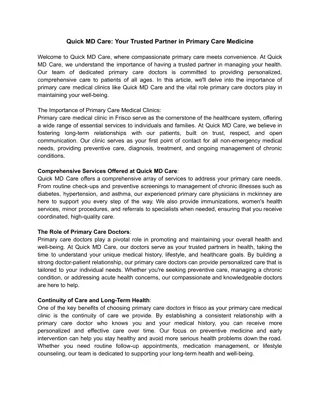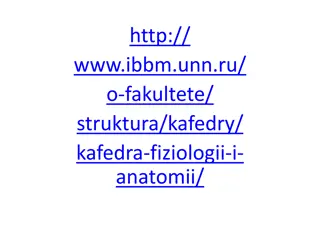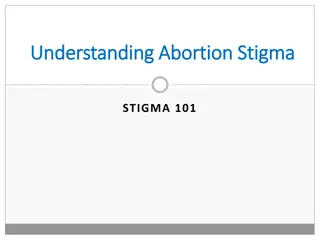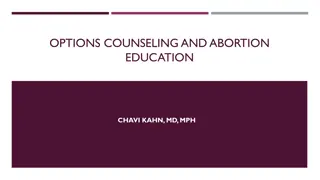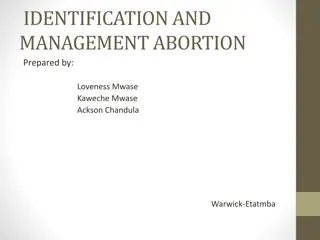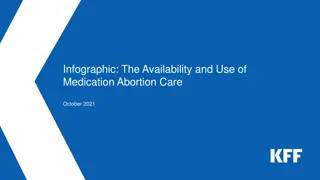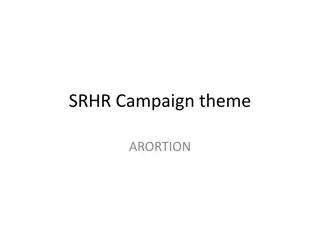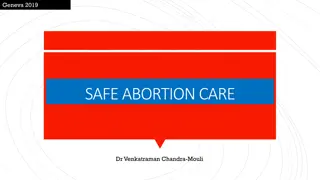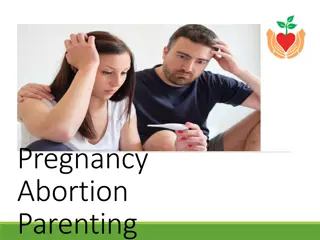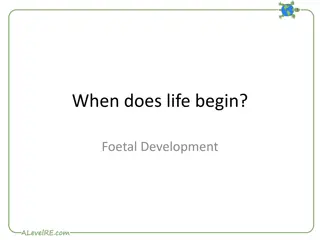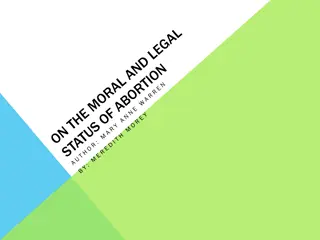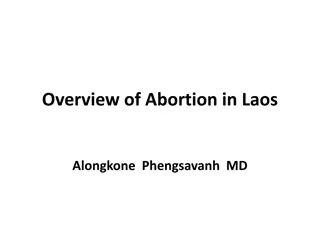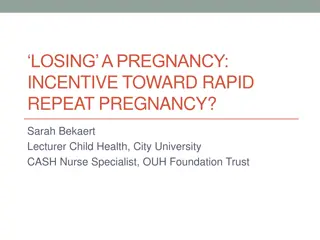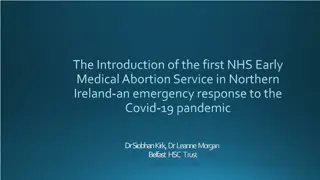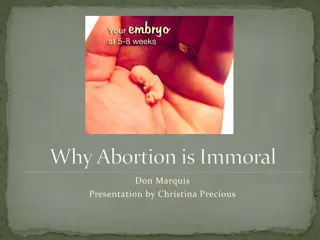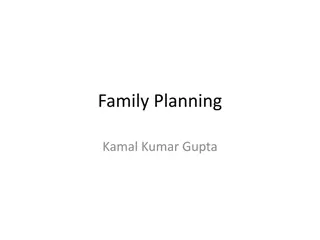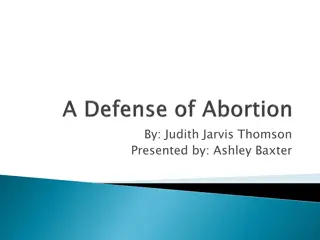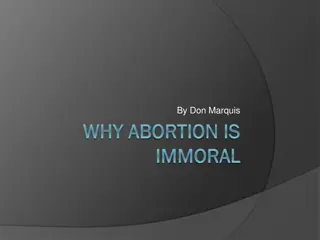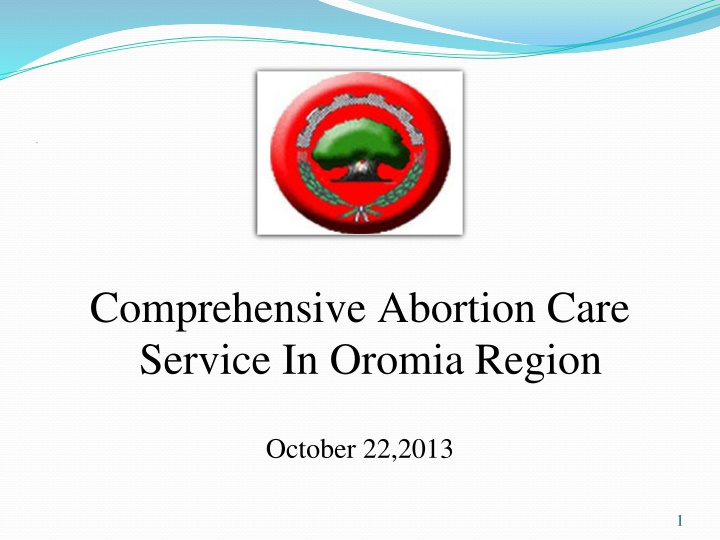
Comprehensive Abortion Care Services in Oromia Region
Explore the provision of comprehensive abortion care services in the Oromia Region, focusing on health system functionality, leading causes of maternal mortality, partnerships with governmental and non-governmental organizations, challenges faced, and lessons learned. The background information of the region, including population, health facilities, and potential coverage, is also highlighted. Additionally, learn about the structure of the health system, the direct causes of maternal mortality in the Ethiopian context, and the legal framework regarding abortion in the region.
Download Presentation

Please find below an Image/Link to download the presentation.
The content on the website is provided AS IS for your information and personal use only. It may not be sold, licensed, or shared on other websites without obtaining consent from the author. If you encounter any issues during the download, it is possible that the publisher has removed the file from their server.
You are allowed to download the files provided on this website for personal or commercial use, subject to the condition that they are used lawfully. All files are the property of their respective owners.
The content on the website is provided AS IS for your information and personal use only. It may not be sold, licensed, or shared on other websites without obtaining consent from the author.
E N D
Presentation Transcript
. Comprehensive Abortion Care Service In Oromia Region October 22,2013 1
Outline of Presentation Introduction Functionality of the health system Leading direct Causes of MM (80%), Ethiopian context GO and NGO Partnership Collaboration Areas with partners Trends of CAC & PAFP service Challenges Lessons 2 10/22/2013
Back ground information of Oromia Region Population = 32,976,276 (89% are farmers) Zones = 18 Admin/Towns = 12 Woreda = 306 Kebele = 7021 Health facilities 1. Public: Hospitals------------- 42 Health centers--- ---1215 Health post-----------6,165 4 10/22/2013
Back ground information NGO and OGO. Hospitals--------- 8 (4 OGO, 4 NGO) Health centers----- 5 Cilinics ..................195 Health posts.............. 5 3. Private health Sectors Hospital.........................4 Different clinics.............1,639 Drug stores, pharmacy---- 966 2. The potential health service coverage is more than 90% 5 10/22/2013
Functionally of the health system The health post provides preventive and promotion health services with basic prevention based treatment The health center provides comprehensive primary health care services and provides technical backup and receiving referral from the health post The primary hospital services mainly focusing on emergency obstetric care service, The general and referral hospitals provide secondary and tertiary health care services respectively provides basic curative 6 10/22/2013
Leading direct Causes of MM (80%), Ethiopian context 1. Unsafe abortion decreased from (32% - 13%) currently 2. Obstetric hemorrhage 3. Hypertensive disease of pregnancy 4. Obstructed labor 5. Sepsis 7 10/22/2013
The Law and Abortion The Revision of The Penal Code May 9, 2005 The Guideline, June 2006 8 10/22/2013
GO and NGO Partnership Oromia Health Bureau works in partnership with different partners on comprehensive abortion care and contraception: Ipas Ethiopia IFHP EngenderHealth Ethiopia, MSI Ethiopa, Dkt Ethiopia FGAE and others Partners forum and mapped to avoid duplication 9 10/22/2013
Collaboration Areas with partners Training of service providers, health managers and pharmacy personnel Information and education dissemination about the revised law, prevention strategies of unsafe abortion Support with supplies and equipment Facility renovation/civil work to ensure quality of service Joint monitoring, supervision and evaluation 10 10/22/2013
Outcomes The health seeking behavior of the communities are improving The number of safe abortion care clients are increasing The number of family planning clients are dramatically increasing over time: Particularly the long acting family planning 11 10/22/2013
Trends of CAC & PAFP service Year 2008 7765 2009 9069 2010 16882 2011 23591 2012 35987 CAC PAFP 5609(72%) 6334(70%) 14163(83.8%) 19295(81.8%) 33531(93%) 12 10/22/2013
Trends of CAC & PAFP service 13 10/22/2013
Challenges Limited capacity to expand services in all facilities Turnover of trained staff Still the infrastructure to reach the grass roots level need more work 14 10/22/2013
Lessons Integration of family planning with abortion care services High commitment of service providers (mid-level) has increased service uptake in a short period of time Promising partnership and collaboration with partners(Ipas, MSIE, EngenderHealth, Dkt, FGAE and others) 15 10/22/2013
. . THANK YOU

